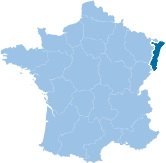In northeastern France the plateau of the Vosges stretches out toward France’s frontier with Germany. Its vast forests are an important source for oak barrels and its many farms produce delicious cheese. At the eastern edge is an escarpment that once had military importance — the ruins of battlements still loom there — but today is important for the slope that runs north to south for about 60 miles as the land descends to the plane of the Rhine. That stretch of towns, some bearing German names, some French, is stunningly picturesque. And its wine is unique and delicious, worthy of a place in every wine lover’s cellar.
In most of France, wine names are exclusively by place. The rules about permitted varietals are kept off the label, and so one needs additional knowledge to ferret out grape types. Not so in Alsace, where the many grapes that thrive here find their way directly onto the label. Alsatian Riesling is a revelation, particularly to a generation of Americans whose impression of riesling came from Blue Nun or Liebfraumilch, insipid wine of no particular interest. In the Alsace it can be at once refreshing and rich. Pinot Noir also finds a home here, both in rosé and in a lighter, less serious red than those from Burgundy. Here, too, German varietals thrive: spicy Gewurtztraminer and simple Sylvaner; Muscat offers yet another aromatic profile. In addition, there is white wine from Pinot blanc, Pinot Auxerrois, and Pinot Gris.


